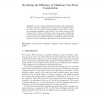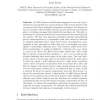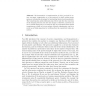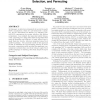SCN
2008
Springer
14 years 7 months ago
2008
Springer
We present an implementation of the protocol of Lindell and Pinkas for secure two-party computation which is secure against malicious adversaries [13]. This is the first running sy...
CCS
2010
ACM
14 years 7 months ago
2010
ACM
Secure two-party computation allows two untrusting parties to jointly compute an arbitrary function on their respective private inputs while revealing no information beyond the ou...
EUROCRYPT
2007
Springer
14 years 11 months ago
2007
Springer
In a recent paper Mohassel and Franklin study the efficiency of secure two-party computation in the presence of malicious behavior. Their aim is to make classical solutions to this...
EUROCRYPT
2007
Springer
14 years 11 months ago
2007
Springer
We show an efficient secure two-party protocol, based on Yao's construction, which provides security against malicious adversaries. Yao's original protocol is only secur...
AC
1998
Springer
14 years 11 months ago
1998
Springer
Abstract. In 1982, Bennett and Brassard suggested a new way to provide privacy in long distance communications with security based on the correctness of the basic principles of qua...
EUROCRYPT
2003
Springer
15 years 10 days ago
2003
Springer
Abstract Benny Pinkas HP Labs Abstract. We demonstrate a transformation of Yao’s protocol for secure two-party computation to a fair protocol in which neither party gains any sub...
FOCS
2003
IEEE
15 years 12 days ago
2003
IEEE
We consider the problem of constructing a general protocol for secure two-party computation in a way that preserves security under concurrent composition. In our treatment, we foc...
CRYPTO
2007
Springer
15 years 1 months ago
2007
Springer
Round complexity is a central measure of efficiency, and characterizing the round complexity of various cryptographic tasks is of both theoretical and practical importance. We show...
ACNS
2009
Springer
15 years 1 months ago
2009
Springer
Abstract. This paper examines secure two-party computation of functions which depend only on the Hamming distance of the inputs of the two parties. We present efficient protocols f...
CCS
2010
ACM
15 years 1 months ago
2010
ACM
In this paper, we introduce a framework for secure two-party (S2P) computations, which we call bureaucratic computing, and we demonstrate its efficiency by designing practical S2P...




